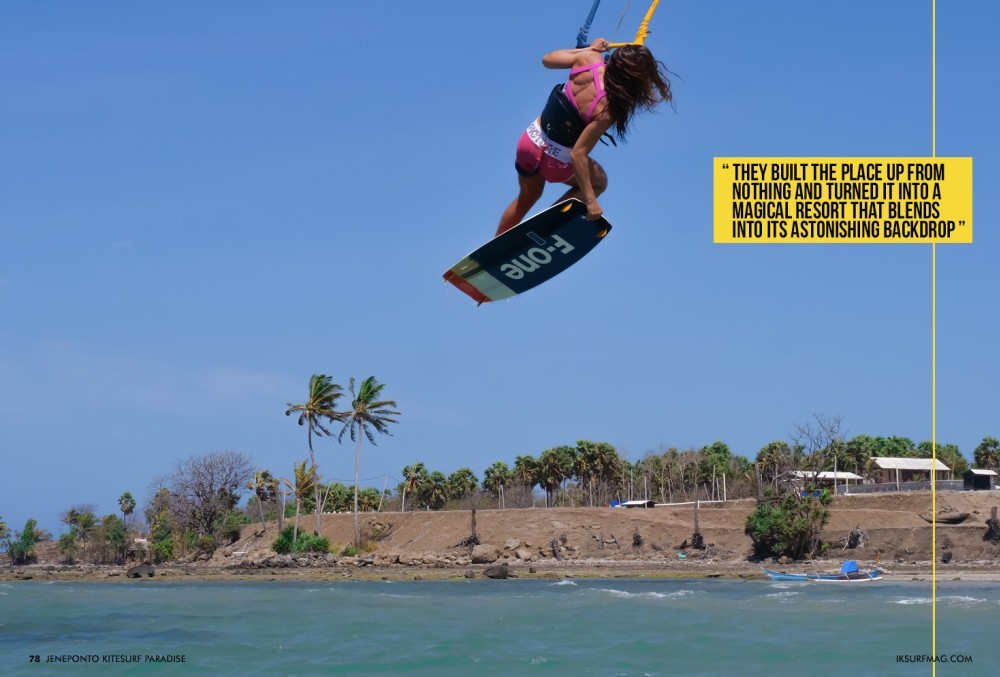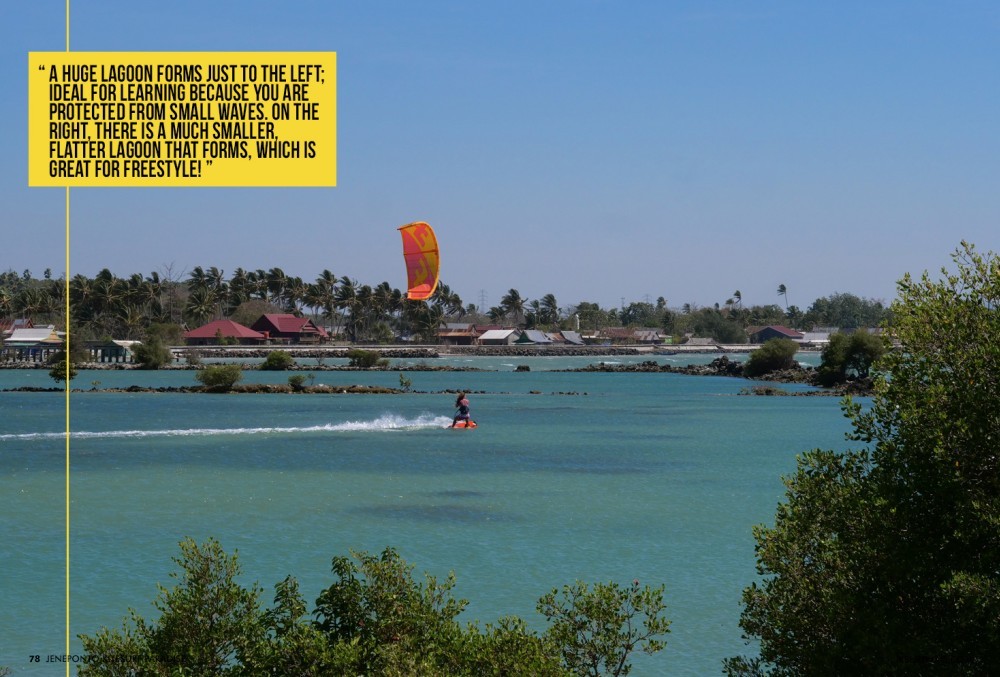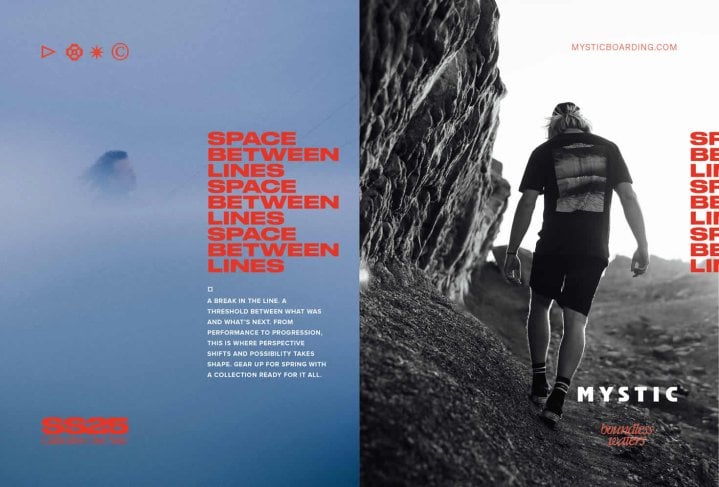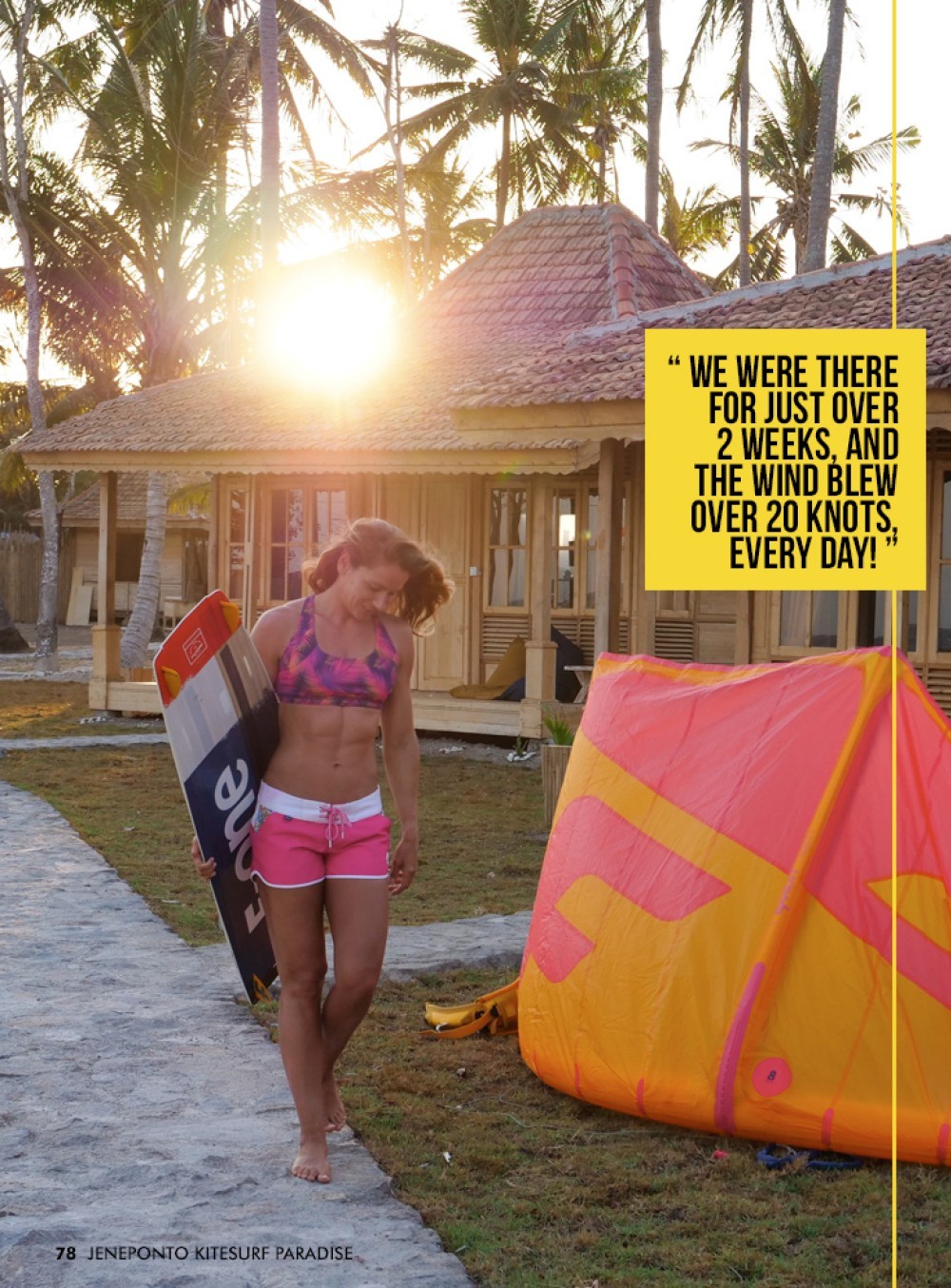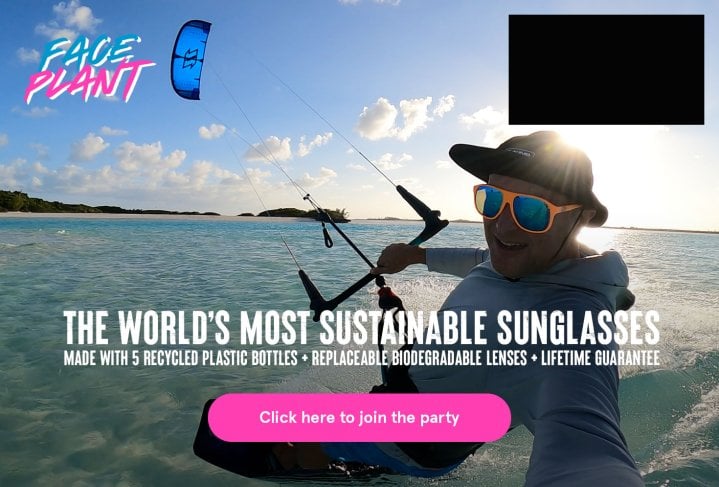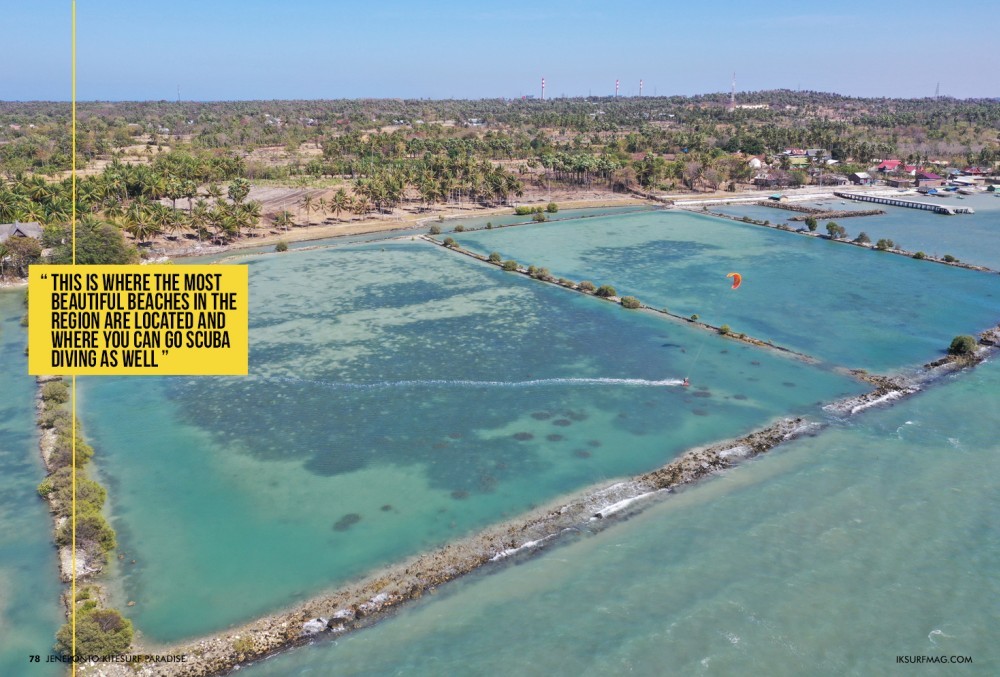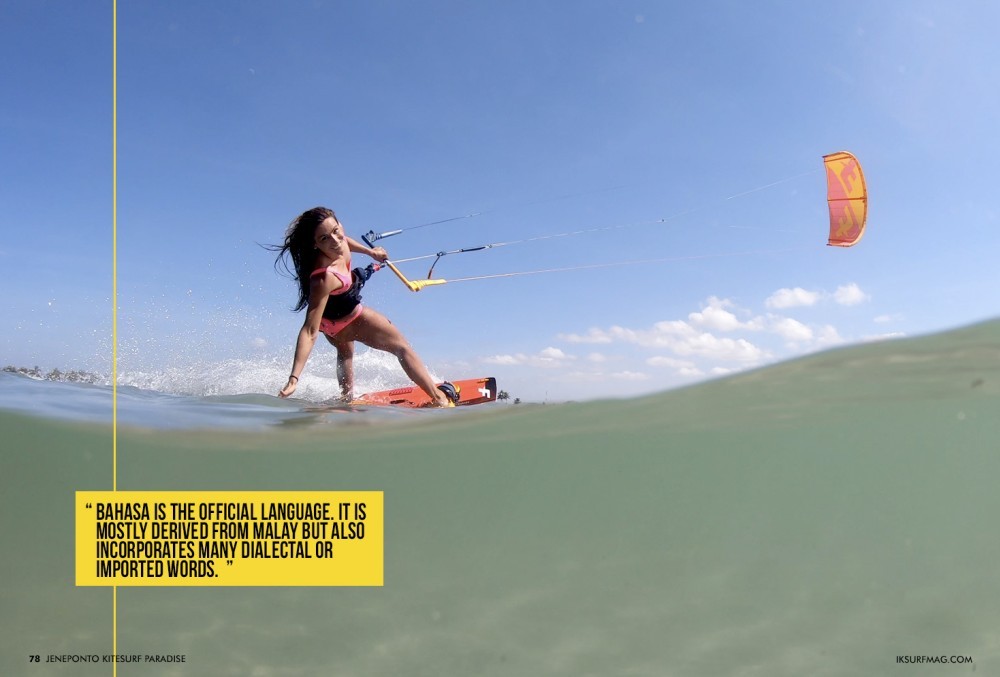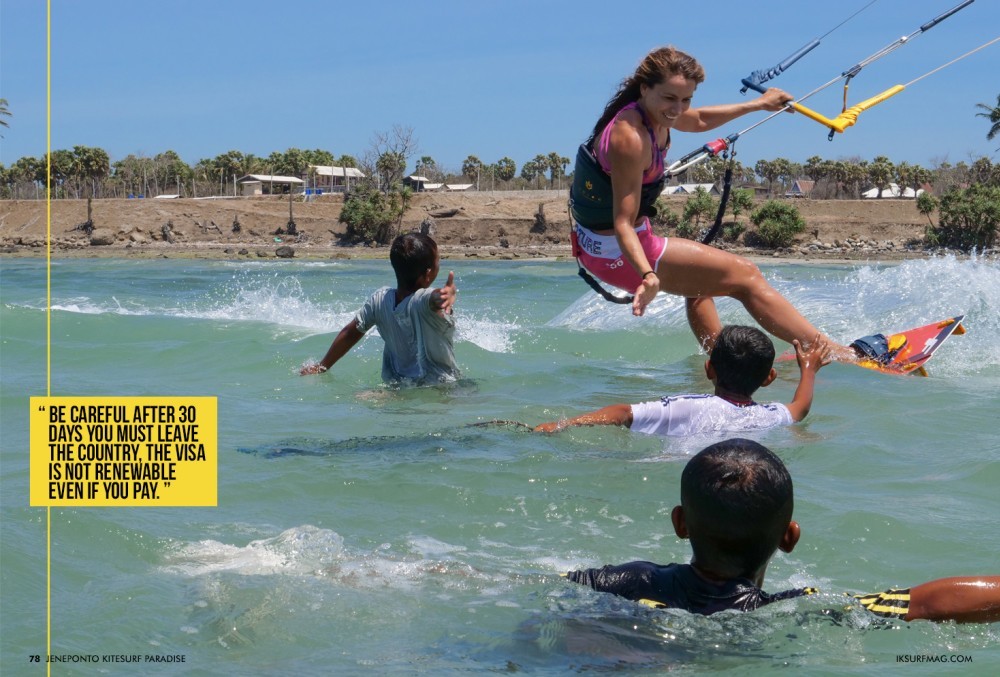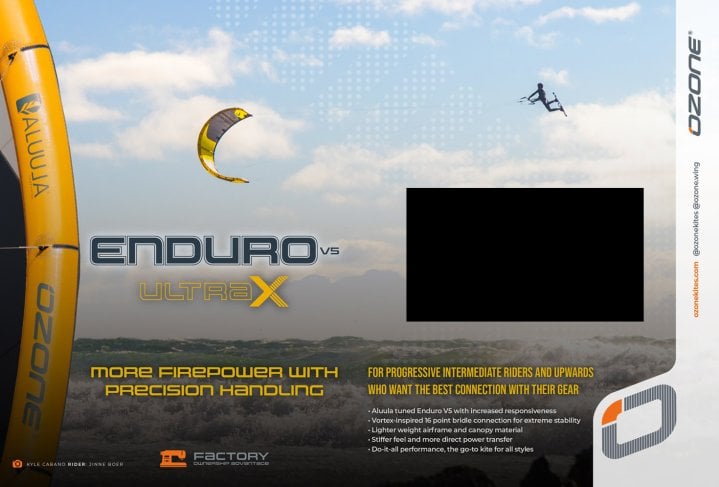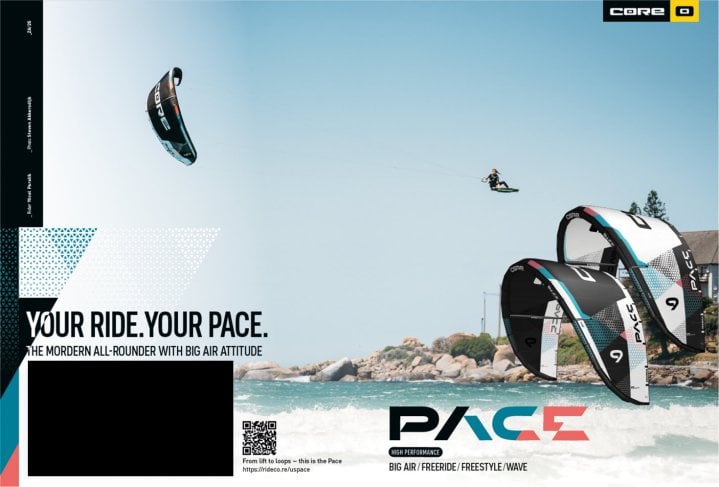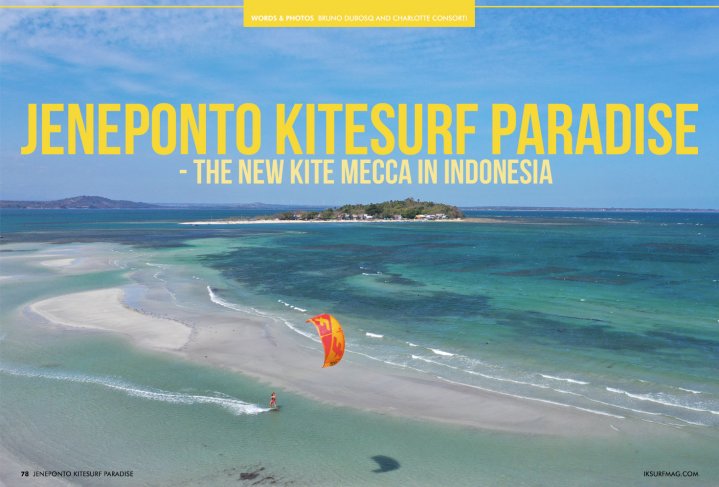
Jeneponto Kitesurf Paradise
Issue 78 / Wed 11th Dec, 2019
Always on the hunt for new kite spots Charlotte Consorti has discovered a new kite paradise in Indonesia, with plenty of wind and lots of flatwater it looks pretty amazing to us! Check it out right here!
Jeneponto Kitesurf Paradise - The new kite mecca in Indonesia
Indonesia has always been on my bucket list, so when I noticed that an F-ONE School in Banda Aceh had started up a new kiteboarding camp, it immediately appealed to me. Sulawesi, also known as Celebes, is one of the five main Indonesian islands, the eleventh largest island in the world and above all, its turquoise lagoons and coconut trees remain undiscovered by the masses!
I checked the wind statistics for the spot, and to my surprise, it forecasted a 95% chance of 20+ knots of wind - I was game! The kite camp was due to start July 1st, but when I tried to book, it was already full! I emailed the organizers, Alice and Régis, and they managed to pull some strings and book us in for the end of the August.
Alice and Regis are both French but fell in love with Indonesia years ago! Alice manages the accommodation and restaurant at the resort on this slice of paradise, while Regis is in charge of all things kiteboarding related.
To get to Jeneponto, it’s best to land at Makassar airport. There are no direct flights from Europe yet, but there are multiple flights from Singapore, Kuala Lumpur, Bali or Jakarta. Once you arrive, you'll have to book a taxi to Jeneponto (more specifically Mallosoro; a small fishing village where the spot is located). The taxi journey should take you approximately two hours. Arriving at a new kiteboarding destination must be one of the best feelings in the world; would you agree?
Alice and Régis have done an incredible job with the place. They built the place up from nothing and turned it into a magical resort that blends into its astonishing backdrop. Twelve bungalows made of wood species native to South Sulawesi; the same wood used to construct the traditional two-masted sailboats. The roofs are made of conventional tiles that have a classic Indonesian shape called Joglo (shaped like a pyramid) For me, the most dazzling thing was the outdoor bamboo bathrooms; nothing beats going to the toilet at night while staring at the stars!
The kiteboarding spot is literally a stone-throw away from your room, and you can set up your kite on the grass by the pool and go walk right into the water.
The spot changes depending on the tide. The best time is at high tide, a huge lagoon forms just to the left; ideal for learning because you are protected from small waves. On the right, there is a much smaller, flatter lagoon that forms, which is great for freestyle! Make sure you keep an eye out for the villagers' boat though, you don't want to drop your kite on them! If you are into strapless riding, you will find some small waves. The waves are usually too small to surf, but it's still enough to have fun on strong wind days. If you are an experienced rider, just under a kilometre downwind, you'll find old aquaculture lagoons that form three new flatwater pools. Wait for high tide and then jump a small rock fence to enjoy these playgrounds!
If you are not kiteboarding, you'll love exploring the bay and visiting the small fishing island in front of the resort. There’s something for everyone!
Unfortunately, you might be a little disappointed if you’ve brought your foil board! There is quite a lot of seaweed and large rectangles squared by ropes attached to plastic bottles. Algae cultivation is the primary resource of the village. They collect them on foot at low tide in bamboo baskets or at high tide they pile them up in their boats. They then dry them in the sun on large plastic tarpaulins in front of their homes. They then sell them by the kilo. They are exported everywhere in the world; you'll even find them in your cosmetics.
The spot benefits from an acceleration of the trade winds, thanks to the surrounding mountains but also to a peak effect, and it is no coincidence that one of Indonesia's largest wind farms can be seen in the distance on the mountains. The wind blows like this non-stop from April to October. We were there for just over 2 weeks, and the wind blew over 20 knots, every day! We would would get up between 8:00 am - 9:00 am, and the wind would generally start as soon as the sun rises, reaching 30 knots by late morning. I've never experienced such a promising wind forecast, except for maybe in Madagascar.
We had initially planned to move around a little bit and go sightseeing, but it's hard to find the incentive to do that when you have kiteboarding conditions like these, literally at your doorstep! We also didn't anticipate that the roads were not well adapted to the traffic. One day, it took us two and a half hours by taxi to get from Makassar to the kite spot. Makassar is extremely congested, but even when you leave the city traffic jams, it remains challenging because the roads are winding, poorly maintained and very narrow. Trucks, cars, scooters, pedestrians, goats, and cars share a road, where two vehicles can barely pass through; all it takes is an accident or a broken-down vehicle to block traffic for hours.
I wouldn't say that Indonesians drive badly, but they have their own driving style that is difficult to understand! They honk to prevent crashes, which turns into a constant hum! It must be only a matter of habit and adapted hearing, but I wouldn't recommend you rent a car!
Don't over plan your travel itinerary! The easiest place to visit is Bira, which is about three kilometres away. This is where the most beautiful beaches in the region are located and where you can go Scuba diving as well. Keep in mind though that Bira is very popular amongst the locals on weekends, so make sure you book in advance.
If you want to do something a little different, away from the sea, there are some incredible waterfalls to visit in the countryside. Régis and Alice are always happy to give you advice, and they will even organize the trip for you.
As a photographer, I rarely take portraits of people when I travel, as some cultures don't appreciate it. One morning, I took a walk with the sole intention to get some photos alleyways and the architecture of the houses, but I was stopped by the locals asking me to take photos of them! They thanked me and gave me presents. They didn't even want to see the photos; they were just happy to have their photo taken! Despite the language barrier, it was a great exchange of laughter and smiles.
Over two weeks of non-stop kiteboarding, it was time to head home! The spot kept its promise as the windiest place in Indonesia! It's not easy to leave this little paradise and the whole Batikite Resort team. Between the incredible wind statistics, the kindness and hospitality of the people and the beauty of the spot, I think I was lucky to experience it before everyone else!
Practical Information
How to Get There
The spot is located in the village of Mallasoro, 80 km from Makassar and its international airport: Sultan Hasanuddin Airport (UPG).
To get to Makassar from Europe, book your flight through Singapore, Kuala Lumpur, Jakarta or Bali. Several airlines offer these flights, but I recommend Singapore Airlines with a transit in Singapore. The flight price should range between 700 and 800 euros.
When to Go
The wind blows from April to November. The strongest months are June/July/August/September with 98% wind and an average speed of more than 20 knots.
Where to Book
Batikite Resort, the only hotel in the region!
https://indonesiakitesurfing.com
Currency
The local currency is the Indonesian Rupee (IDR) called RUPIAH.1€ ~ 15 542 Rp (at 01/09/2019)
There's an ATM at Makassar airport (MasterCard and visa). Withdrawals are limited; I was able to withdraw 127 euros max or 2,000,000 rupees; you're a millionaire!
Time Difference
Jeneponto is in the UTC/GMT+8 time zone, and there is no time change, so with France, there is a +6h time difference in summer and +7h in winter.
Electricity
Electricity is at 220 volts and 60 hertz; the sockets are identical to those in France. All bungalows are equipped with C, E, F sockets.
Language
Bahasa is the official language. It is mostly derived from Malay but also incorporates many dialectal or imported words. There are about 250 languages and dialects spoken in Indonesia. But all of them, except for most elders, speak Bahasa and have some basic English.
Scooters and Car Rental
Batikite Resort offers scooters for rent at 75000 rupees per day or about 5 euros. The resort does not rent a car, but they can put you in touch with a rental company. You’ll pay about 700,000 rupees or 45 euros.
Gasoline prices are roughly 10000 rupees/litre or about 60 cents of euros per litre. In Makassar, you can get an app on your phone called 'GRAB' for taxis.
Phone and Internet
There is a network everywhere, and the resort offers free Wi-Fi in the common areas at 4G speed.
Formalities and Visas
You must have a passport with a validity of more than 6 months. No need for a visa for a stay of less than 30 days for French nationals. But be careful after 30 days you must leave the country, the visa is not renewable even if you pay.
For a stay of more than 30 days, you can apply for an arrival visa (VOA) from the immigration authorities. (60 euros for 60 days).
In all cases, you must be in possession of a return ticket or other proof of leaving the country.
Health
No vaccinations are required, but diphtheria-tetanus-polio vaccination (DTP) is recommended, rubella-mumps-measles (MMR) vaccination for kids, and anti-tuberculosis vaccination is also advisable.
During the dry season (April to November) the wind blows mosquitoes away in the daytime, but there may be some at night. The bungalows are equipped with mosquito nets and air conditioning. The risk of malaria in Indonesia varies considerably from one island to another, so make sure you know how to leave, especially since the map varies according to climatic events. I'd recommend you take precautions anyway; mosquitoes can also transmit other diseases (dengue fever, chikungunya, Japanese encephalitis or Zika virus). I didn't take any treatment for malaria because I stayed only in Mallasoro where the risk was low. There are doctors in Jeneponto, and the nearest hospital is in Makassar. The other most common risks are tourism and sunburn!
By Charlotte Consorti




